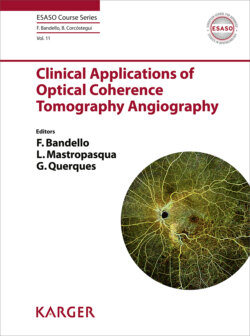Читать книгу Clinical Applications of Optical Coherence Tomography Angiography - Группа авторов - Страница 16
На сайте Литреса книга снята с продажи.
Limitations of OCTA
ОглавлениеDespite the valuable insight OCTA has offered into the pathogenesis and features of dry AMD, it is still an evolving technique that is not without its limitations. OCTA images are prone to degradation by motion and projection artifacts [48]. Projection artifacts occur when superficial retinal blood vessels scatter light that is reflected by other deeper reflective layers. As a result, during segmentation, larger superficial retinal blood vessels may falsely appear in deeper layers, obscuring visualization of true vascular pathology. Since OCTA analysis of dry AMD is focused on visualization of the choroid and deeper retinal layers, projection artifacts must be kept in mind during image analysis to avoid inaccurate detection of flow. Furthermore, as discussed earlier, drusen can cast shadows underneath, which may be falsely interpreted as decreased flow in the underlying CC. However, analysis coupled with en face OCT intensity images can assist in avoiding such error.
Additional artifact may be generated due to the underlying larger choroidal vessels as well. With CC atrophy, choroidal vessels are more readily visualized, but also may migrate upwards, closer to Bruch’s membrane, occupying the generated void. These vessels may confound the OCTA image, demonstrating CC flow when there is actually CC flow impairment or atrophy.
Despite its limitations, OCTA has expanded upon our previous knowledge of dry AMD, to allow further insight into the development and progression of this pathology. With future developments offering artifact-removal algorithms, a wider field of imaging, longer wavelength light sources for increased depth-penetration, faster imaging speeds, and an improved VISTA technique, OCTA remains a promising technique for detecting and monitoring retinal and choroidal changes in dry AMD.
